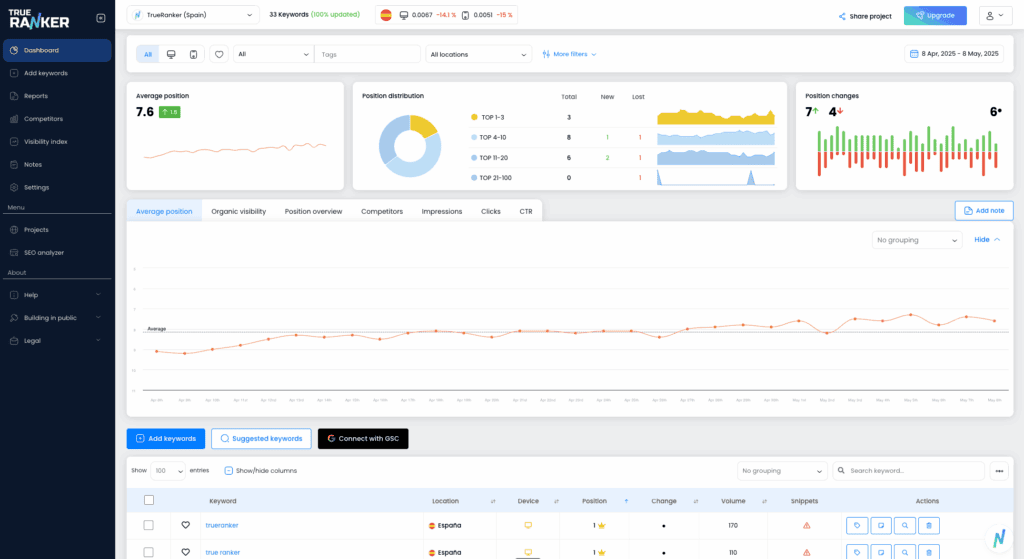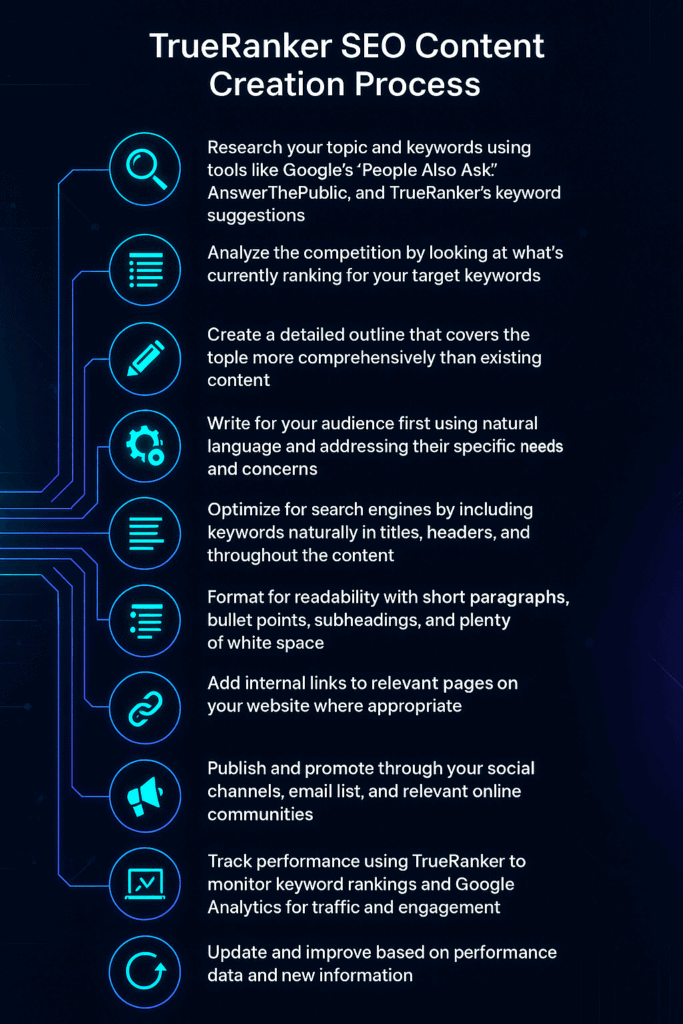Contents
ToggleWhy does your amazing content get zero traffic?
You spent hours crafting what you thought was a great blog post. It’s informative, well-written, and genuinely helpful. You hit publish with excitement, expecting visitors to pour in. Instead? Crickets.
Sound familiar? Here’s the tough truth: creating great content isn’t enough anymore. If that content isn’t optimized for search engines, it’s like hosting an incredible party but forgetting to send out invitations.
But here’s the good news, creating SEO content in 2025 doesn’t mean sacrificing quality or writing like a robot. In fact, it’s quite the opposite. The businesses winning online today are those that understand one simple principle: write for humans first, optimize for search engines second.
Let me show you exactly how to write content that both your readers and Google will love.
What exactly is SEO content and why should I care in 2025?
SEO content is simply content created with search engines in mind, but, and this is crucial, without sacrificing what makes content genuinely valuable to readers.
Think of it like a bakery creating the most delicious, healthy, artisan bread in the city but that it is so hidden that nobody can find it, with no sign outside, no online presence. If you want your bread to be sold, you need to make it findable. Both elements are essential.
In 2025, this balance matters more than ever because:
- Google’s algorithms have gotten incredibly sophisticated at detecting content quality
- Readers have higher expectations, they can spot fluff from a mile away
- Competition is fierce, so mediocre content simply won’t cut through the noise
- User experience signals (like time on page and bounce rate) directly impact rankings
Why This Matters: Content that ranks well but doesn’t engage readers will eventually lose its rankings. Content that engages readers but can’t be found won’t grow your business. You need both.
Here’s my honest take: Most “SEO content” advice from 2015-2020 was about gaming the system. Today’s approach is about genuinely serving your audience while making it easy for search engines to understand and recommend your content.
How do I determine what content to write?
The biggest mistake we see small businesses make? Creating content they think people want instead of content people actually search for.
When we first started TrueRanker’s blog, we wrote detailed technical articles about crawler behavior and indexing algorithms. We thought we were being helpful. Spoiler alert: our target audience of small business owners wasn’t searching for that information. Our traffic was practically nonexistent until we shifted to topics they actually cared about.
Start with your audience’s real questions
Before writing a single word, ask yourself:
- What problems does your product or service solve? Each problem is potential content
- What questions do customers ask before, during, and after purchasing? These are golden content opportunities
- What misconceptions do people have about your industry? Perfect for myth-busting articles
- What seasonal or trending topics relate to your business? Great for timely content
Use these tools to validate content ideas:
- Google’s “People Also Ask” sections for related questions
- AnswerThePublic for question-based content ideas
- TrueRanker’s keyword suggestions to see what terms are actually being searched
- Your own customer service emails and support tickets (seriously, this is a goldmine)

SEO Simplified: Don’t guess what people want to read. Let their actual search behavior guide your content strategy.
Pro tip: Keep a running document of every customer question you receive. These aren’t just content ideas, they’re pre-validated topics that you know people actually care about.
What makes content valuable in 2025?
Google has made it crystal clear: they want to reward content that demonstrates E-E-A-T (Experience, Expertise, Authoritativeness, and Trustworthiness). But what does that actually mean for a small business owner?
High-quality content in 2025 means:
1. It solves real problems comprehensively. Don’t just scratch the surface. If someone searches for “how to choose a business insurance policy,” they want the full picture, types of coverage, cost factors, common mistakes, and actionable next steps.
2. It demonstrates genuine experience. Share specific examples, case studies, and lessons learned. Generic advice is everywhere. Your unique perspective and experience are what set your content apart.
3. It’s formatted for actual humans. Use subheadings, bullet points, short paragraphs, and white space. If your content looks like a wall of text, readers will bounce, and Google notices bounce rates.
4. It stays current and accurate. Outdated information isn’t just unhelpful, it can be harmful to your credibility. Plan to update your content regularly.
Why This Matters: Google can detect content quality signals like time on page, return visits, and social shares. Quality content naturally generates these positive signals.
What Google considers low-quality content:
- Thin content with little substance (under 300 words for most topics)
- Content clearly written primarily for search engines rather than humans
- Duplicate or near-duplicate content from other sources
- Content with numerous factual errors or outdated information
- Articles that don’t match the search intent behind target keywords
Here’s a reality check we learned the hard way: We once published a series of short, keyword-focused posts that hit all the “technical” SEO requirements but provided minimal value. They initially ranked okay, but within six months, they’d all dropped out of the top 50. Google’s algorithms had caught up with the thin content.
How do I optimize my content for search engines?
Now comes the technical part, but don’t worry, we’ll keep this practical and straightforward.
The foundation: On-page SEO essentials
Title Tags and Headlines Your title tag (what shows up in search results) should include your target keyword naturally while accurately describing what the content covers. Keep it under 60 characters to avoid truncation.
Good example: “Small Business Insurance Guide: Types, Costs, and How to Choose” Bad example: “Insurance, Business Insurance, Small Business Insurance Coverage Guide”
Header Structure (H1, H2, H3) Use headers to organize your content logically. Your H1 should be your main title, H2s for major sections, and H3s for subsections. This helps both readers scan your content and search engines understand your structure.
Meta Descriptions While not a direct ranking factor, meta descriptions influence click-through rates from search results. Write compelling descriptions that accurately summarize your content in 150-160 characters.
Internal Linking Link to other relevant pages on your website where it makes sense. This helps search engines understand your site structure and keeps readers engaged longer.
Content optimization that actually works:
1. Use keywords naturally. Include your target keyword in your title, first paragraph, and a few subheadings, but focus on natural language. If you’re forcing keywords into awkward sentences, you’re doing it wrong.
2. Cover topics comprehensively. Don’t just answer the main question, address related questions and concerns. Google rewards content that thoroughly covers a topic.
3. Optimize for search intent. If someone searches “best project management software,” they want comparisons and recommendations, not a history of project management. Match your content to what searchers actually want.
4. Add relevant images and optimize them. Use descriptive file names and alt text for images. This helps with accessibility and gives search engines more context about your content.
SEO Simplified: Good on-page optimization feels invisible to readers but makes your content crystal clear to search engines.
Real example: From invisible to discovered
Mini Case Study: Local Marketing Agency’s Content Transformation
A small digital marketing agency in Melbourne was struggling to attract new clients through their website. They had a blog, but their posts were getting maybe 20-30 views each and generating zero leads.
Their original approach:
- Generic posts about “digital marketing trends”
- Thin content (400-500 words)
- No clear target audience
- Basic keyword stuffing
What they changed:
- Focused on specific local business problems: “How Melbourne Restaurants Can Use Instagram to Fill Tables During Slow Periods”
- Created comprehensive guides (1,200+ words) with actionable steps
- Added local examples and case studies from their own client work
- Optimized for local search terms while maintaining natural language
Results after 4 months of tracking in TrueRanker:
- Average blog post views increased from 25 to 300+
- 12 of their 15 target keywords moved to page 1 or 2
- Generated 8 qualified leads directly from blog content
- Organic traffic increased by 180%
The agency owner’s feedback: “We stopped trying to impress everyone and started helping our specific audience solve real problems. The content became genuinely useful, and the SEO results followed.”
Different types of SEO content that work for small businesses
Not all content serves the same purpose. Understanding these different types helps you create a well-rounded content strategy:
Educational Content (How-to Guides and Tutorials)
Perfect for building trust and demonstrating expertise. These typically target informational search queries and help establish your authority.
Example: “How to Choose the Right Contractor for Your Home Renovation”
Comparison and Review Content
Great for capturing people in the consideration phase of buying. These often have high commercial intent.
Example: “QuickBooks vs. Xero: Which Accounting Software is Right for Small Businesses?”
Local Content
Essential for location-based businesses. Helps you dominate local search results.
Example: “Best Wedding Venues in [Your City]: A Complete Guide for 2025”
Problem-Solution Content
Addresses specific pain points your audience faces. Often converts well because you’re reaching people actively looking for solutions.
Example: “Why Your Website Traffic Dropped (And How to Fix It)”
Industry News and Trend Analysis
Keeps your content fresh and positions you as someone who stays current with your field.
Example: “5 Small Business Marketing Trends to Watch in 2025”
How do I measure if my SEO content is working?
Creating content without measuring its performance is like throwing darts blindfolded. You might hit something, but you’ll never improve your aim.
Key metrics to track:
Ranking positions for target keywords. This is where TrueRanker becomes invaluable. Instead of manually checking Google (which shows personalized results), you can track your actual rankings over time and spot trends before they become problems.
Organic traffic to each piece of content. Use Google Analytics to see which content brings in the most visitors and identify patterns in your successful pieces.
Time on page and bounce rate. These indicate whether your content is actually engaging readers or if they’re leaving immediately after arriving.
Conversion metrics. Track how many readers take desired actions, subscribe to your newsletter, request a quote, download a resource, etc.
Why This Matters: Data removes guesswork from content creation. You can double down on what works and improve or eliminate what doesn’t.
Warning signs your content needs improvement:
- Rankings dropping consistently over 2-3 months
- High bounce rates (over 70% for most industries)
- Low time on page (under 1 minute for long-form content)
- No engagement (comments, shares, or conversions)
When and how to update your existing content
Content isn’t “set it and forget it.” Regular updates can breathe new life into older pieces and improve their search performance.
Update your content when:
- Information becomes outdated (statistics, pricing, regulations)
- You notice rankings dropping for important pieces
- You have new insights or examples to add
- Search trends in your industry shift
- You want to target additional related keywords
How to refresh content effectively:
- Add new sections addressing questions you’ve received since publishing
- Update statistics and examples with current data
- Improve the formatting with better headers, bullet points, or visuals
- Expand thin sections that could be more comprehensive
- Add internal links to newer relevant content you’ve created
One of our most successful content updates involved a guide we’d written about keyword research. After six months, we noticed it was getting good traffic but wasn’t ranking for some obvious related terms. We expanded it by 30%, added a FAQ section, and included more specific examples. Within two months, it jumped from position 8 to position 3 for our main target keyword.
Content creation mistakes that kill your SEO efforts
Let me share the most common content mistakes we see small businesses make, and how to avoid them:
Mistake #1: Writing for search engines instead of humans
The problem: Content that reads unnaturally because it’s stuffed with keywords. The solution: Write for your audience first, then optimize. If it doesn’t sound natural when you read it aloud, rewrite it.
Mistake #2: Not matching search intent
The problem: Creating content that doesn’t match what searchers actually want. The solution: Look at what’s currently ranking for your target keywords. What type of content is Google rewarding?
Mistake #3: Publishing and hoping
The problem: Creating content without any promotion or follow-up strategy. The solution: Share on social media, include in newsletters, reach out to industry contacts, and actively promote your best pieces.
Mistake #4: Ignoring mobile optimization
The problem: Content that’s hard to read on smartphones (where most searches happen). The solution: Use short paragraphs, plenty of white space, and test how your content looks on mobile devices.
Common Myth vs. Reality: Myth: “If I write great content, people will automatically find it.” Reality: Great content needs optimization and promotion to reach its potential audience.
Frequently Asked Questions About SEO Content Creation
How long should my SEO content be?
There’s no magic word count, but comprehensive content typically performs better than thin content. For most topics, aim for at least 1,000 words to cover the subject thoroughly. However, some topics might require 2,000+ words, while others can be effectively covered in 600-800 words. Focus on fully answering the reader’s question rather than hitting an arbitrary word count.
How often should I publish new content?
Consistency matters more than frequency. Whether you publish weekly or monthly, stick to a schedule your audience can expect. For most small businesses, one high-quality piece per month is better than four mediocre pieces. Quality and consistency beat quantity every time.
Should I hire a professional writer or do it myself?
If you have industry expertise and can write clearly, creating your own content often produces the most authentic and valuable results. However, if writing isn’t your strength, consider hiring a professional who can interview you for your expertise and craft it into engaging content. The key is ensuring whoever writes it understands your audience and industry.
How do I know which keywords to target in my content?
Start with keyword research tools to identify terms your audience actually searches for. Look for keywords with decent search volume but manageable competition. Focus on one primary keyword per piece of content, along with 2-3 related secondary keywords. TrueRanker can help you track how well your chosen keywords perform over time.
What’s the difference between content marketing and SEO content?
SEO content is optimized to rank in search engines, while content marketing focuses on engaging and converting your audience. The best approach combines both, creating valuable content that serves your audience while being discoverable through search. Don’t sacrifice one for the other.
Your step-by-step SEO content writing process
Ready to create content that actually gets found and drives results? Here’s your actionable roadmap:
- Research your topic and keywords using tools like Google’s “People Also Ask,” AnswerThePublic, and TrueRanker’s keyword suggestions
- Analyze the competition by looking at what’s currently ranking for your target keywords
- Create a detailed outline that covers the topic more comprehensively than existing content
- Write for your audience first using natural language and addressing their specific needs and concerns
- Optimize for search engines by including keywords naturally in titles, headers, and throughout the content
- Format for readability with short paragraphs, bullet points, subheadings, and plenty of white space
- Add internal links to relevant pages on your website where appropriate
- Publish and promote through your social channels, email list, and relevant online communities
- Track performance using TrueRanker to monitor keyword rankings and Google Analytics for traffic and engagement
- Update and improve based on performance data and new information

Remember, SEO content creation is a marathon, not a sprint. Focus on creating genuinely helpful content for your audience, optimize it properly for search engines, and be patient while tracking your progress.
At TrueRanker, we believe the best SEO content doesn’t feel like SEO content at all, it just feels like exactly what the reader was looking for. When you nail that balance, both your audience and search engines will reward you with better visibility and more business.
